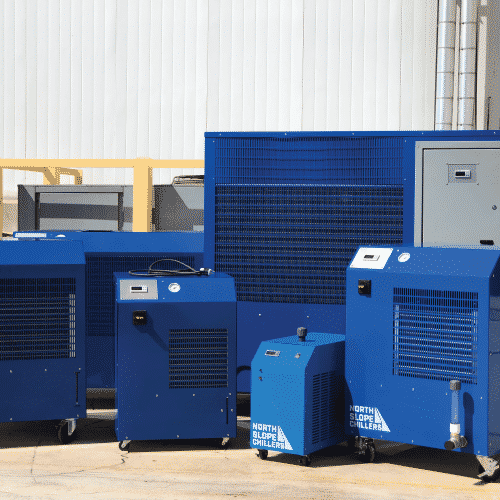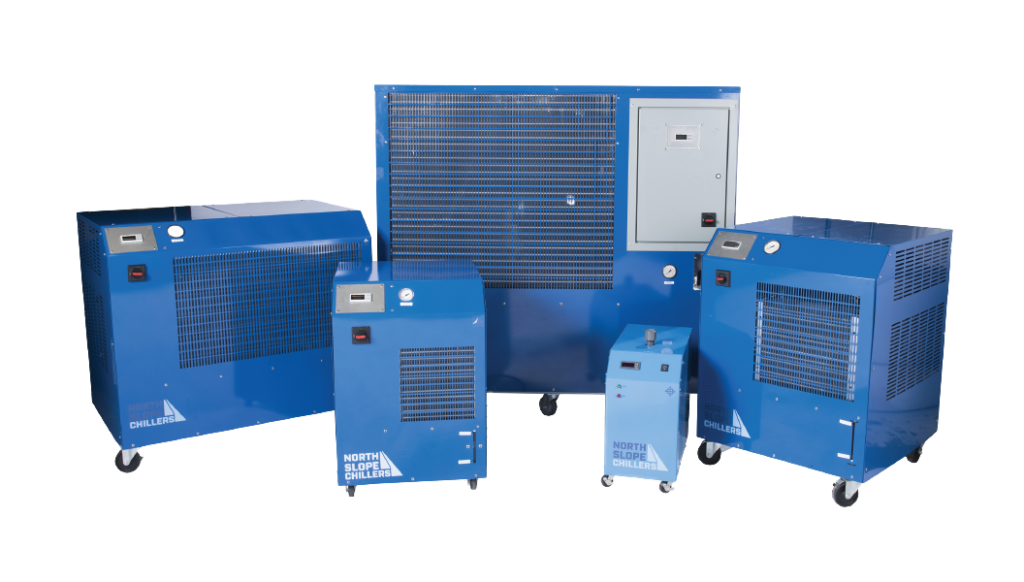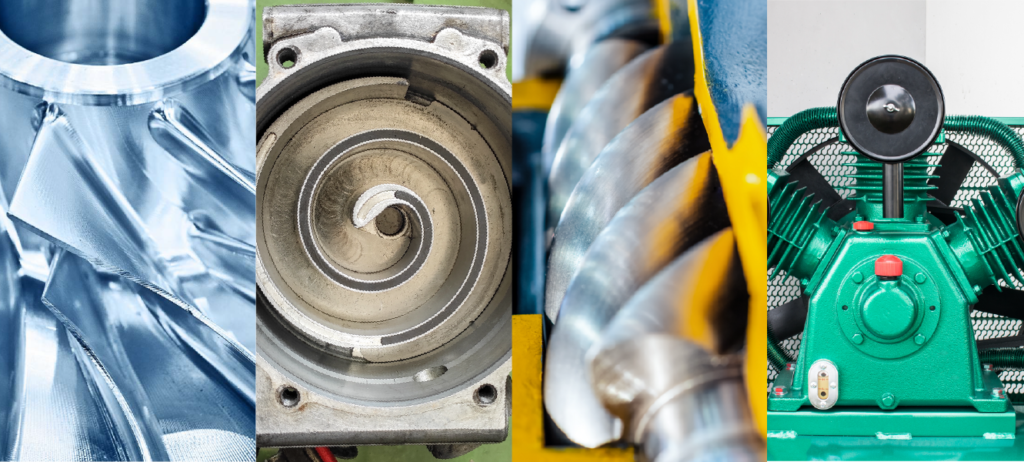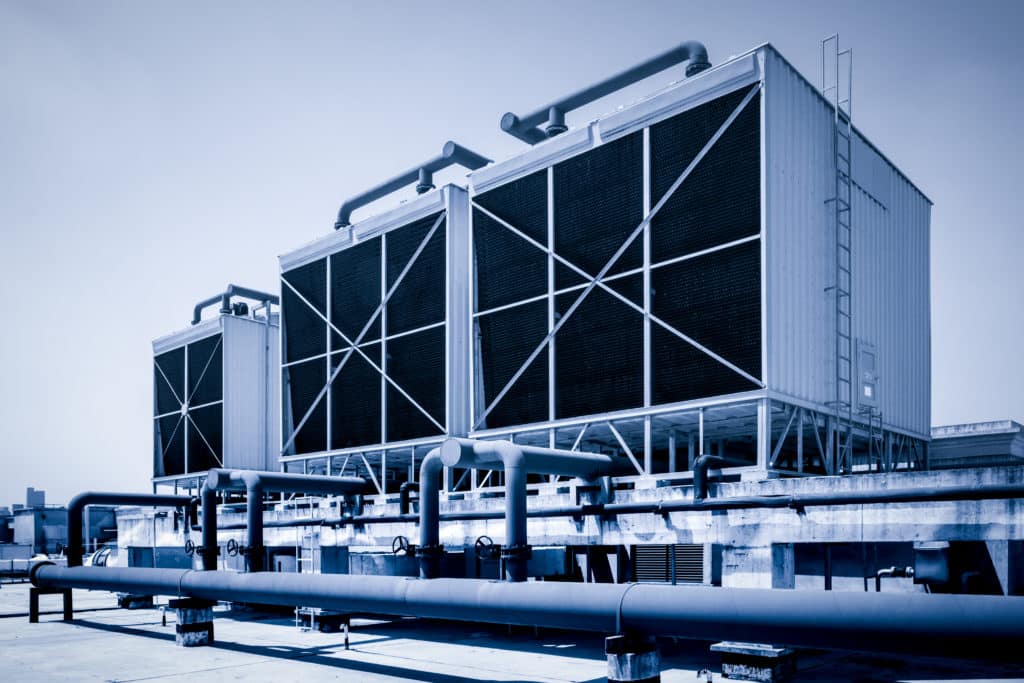The World of Chilling
Since the advent of mechanical chilling, industrial chillers have become a lucrative and crucial component of the global economy. Industrial chilling has fractured into a wide array of solutions and the demand continues to increase each year. The markets that rely the heaviest on chilling are chemical/petrochemicals, manufacturing (especially plastics), machinery (lasers, EDM, CNC machines), agriculture, construction, printing, server cooling, food and beverage processing, rubber manufacturing, and medical/bio-pharmaceuticals.

A Guide To Chilling Terminology
Each industry has specific cooling requirements that necessitate different mechanical components, temperature requirements, power needs, fluids, and more. Let’s take a look at some common industrial chiller terms and their applications.
Main Chiller Types:
Air Cooled Chiller
A class of vapor compression chillers that use forced air to remove unwanted heat from a system, (also known as dry fluid chiller).
Adiabatic Chiller
Adiabatic chillers are water conservation units that reduce cooling water consumption by 20%. These chillers use dampened cooling pads instead of constantly circulating water and can be used dry or wet depending upon peak energy demands.
Vapor Absorption Chiller
A type of chiller that uses an absorber and generator to produce suction and compression in the refrigerant; typically has a larger footprint than vapor compression chillers
Vapor Compression Chiller
A type of chiller that uses an evaporator and compressor to produce pressure in the refrigerant.
Water Cooled Chillers
A class of vapor compression chillers that uses water circulating through a cooling tower to remove unwanted heat from a system.

Cool Variations:
Industrial chillers have become highly specialized for a huge variety of applications. Innovative energy sources, heat dispersal methods, alternate fluids, and special internal/external components make these variations very “cool.”
Air Conditioner
Typical air conditioners are chiller units that use cooled liquid to remove heat and humidity from the air and expel waste heat out of an occupied building or vehicle. Air conditioners are primarily used to provide comfortable climate control.
Air Handler
An air handler is a unit that contains all the mechanical components needed to move air throughout a space. Air handlers can be used for climate control with either an air conditioner or heater.
Ammonia Chiller
In order to reduce a chiller’s carbon footprint and lifecycle operating costs, a few manufacturers are using ammonia as a refrigerant instead of typical hydrofluorocarbons (HFCs). Ammonia chillers are not widely used as of yet, but appear to be generally more energy efficient than other models.
Counterflow Chiller
Counterflow chillers are most commonly used for brewing. A counterflow wort chiller is a coiled section of double layered tubing. Hot liquid wort is gravity fed through the inner tube in one direction, and cold liquid is pumped through the outer tube in the opposite direction. This counterflow in opposite directions greatly speeds up the heat transfer process and cools the wort quicker.
Dual Condenser Chiller (Heat recovery chiller)
In the quest for more sustainable methods of cooling, some manufacturers are creating chillers with 2 different condensers. These chillers recover the waste heat and use it to heat water for other needs. They are extremely useful for building owners that need cool climate control as well as water heaters for restrooms, cleaning, or other uses.
Dual condenser chillers (or heat recovery chillers) can be very environmentally friendly, and save the owner on operating costs. Some tech companies install dual condenser chillers in their data centers and even pipe hot water into nearby towns to help generate community support.
Engine Driven Chiller (propane chiller, natural gas chiller)
Industrial chillers can be designed to operate off of a gas powered engine instead of electricity. These engine driven chillers are typically powered by either propane or natural gas, which are both clean burning fuels. Because gas flow rate can be adjusted, gas powered chillers can operate at flexible cooling rates to fit the application’s needs. These chillers enable users to continue to cool even during peak electric times.
Evaporative Condenser Chiller
All around us, the process of evaporation is constantly dispelling heat into the ambient air. Evaporative condenser chillers use this cooling method to remove waste heat. Recirculated water continuously wets bare condenser tubes while fans force air over the top and evaporate the condensation. These chillers typically use less water than water cooled chillers.
Geothermal Chillers
Anyone who has ever ventured into a cave has noticed the stability of a cave’s temperature even during the extremes of summer and winter. Consistent geothermal heat from the Earth’s mantle is constantly rising up to the crust on which we live. Geothermal chillers are built to use this heat as both a power source and a heat sink for waste heat. Their specialized pumps move air or water back and forth from the building to a ground depth between 100-200 ft.
Immersion Cooling
The act of submerging of a hot object into a bath of water has been around for ages as a common blacksmith cooling practice. But in recent years, this ancient method is being strategically applied to mechanical chillers. Some innovative data centers have begun cooling computer components in a specialized liquid that is not electrically conductive (called dielectric coolant). These cooling liquids can be made of mineral oil, fluorocarbon fluids, deionized water, or other synthetic proprietary coolants.
Industrial Spot Cooling
Large buildings in need of cooling are like a leaky sieve. Windows, loading docks, doors, and other external openings allow a lot of heat to penetrate the building, overwork chillers, and increase energy uses and costs. Some of these buildings are choosing to use strategic spot cooling instead of just blowing cool air throughout the entire building. Spot cooling targets heat sources directly instead of bathing the entire environment. Chilled air is focused on heat sources like machinery, equipment, and concentrations of warm human bodies.
Inline Chilling
Inline chillers simply bring cooling power directly to the production line. Instead of moving materials off the conveyor belt to be chilled as they are processed, automated chillers can be installed directly into the manufacturing line to cool products as they pass by.
Marine Chiller System
Marine chillers circulate cold freshwater through pipes onboard boats and other sea vessels. Air is then forced over these cold pipes to provide cooling for cabin comfort and machinery.
Outdoor Chiller
Industrial chillers can be specially designed to be installed outdoors (such as on rooftops). These units are packaged to provide extra protection for vents, wiring, electronics, and moving parts to protect them from rain, dust and other contaminants.
Recirculating Chiller
Recirculating chillers continuously pump water or other cooling fluids (like a water/glycol mix) through their system. Closed loops chillers that re-use these fluids can greatly reduce water usage and operating costs.
Spindle Chiller
CNC and other vertical machining units generate a great deal of highly focused heat in their spindles. An overheating spindle can be dangerous, destructive, and very costly to repair or replace. Spindle chillers are specialized chillers that continuously run cool fluid through the spindle itself to remove waste heat.
Compressor Types:

Centrifugal Compressor
A type of compressor that uses rotating impellers to compress and push refrigerant around the refrigeration circuit.
Magnetic Bearing Compressors
These specialized centrifugal compressors do not need oil lubricant in order to operate. Instead, the compressor turns with the help of magnetic ball bearings that greatly reduce friction. Less friction means less noise, reduced energy use, and less heat, which increases the chiller’s efficiency. The magnetic bearings also allow the compressor to operate at variable speeds for partial cooling needs or full cooling needs. These compressors have become extremely useful for the U.S. Navy, and their applications continue to expand every year.
Reciprocating Compressor
A type of compressor that uses pistons and chambers that increases the pressure of the refrigerant.
Screw Compressor
This compressor uses interlocking helical rotors to compress refrigerant and are much more quiet than reciprocating compressors.
Scroll Compressor
A type of compressor that uses 2 spiral plates (1 rotating, 1 fixed) to compress refrigerant.
Variable Speed Scroll Compressor
Variable speed compressors speed up or slow down to accommodate fluctuating cooling needs. They are most commonly used in HVAC systems to keep buildings at a target temperature instead of running continuously.
Digital Scroll Compressor
These compressors are digitally programmed to turn on or off as needed. Modulating the compressor in this manner enables the chiller to change its operation as cooling loads fluctuate.
Hermetic and Semi-Hermetic Compressor
To protect the interior of a compressor from dirt and other debris, some compressors can be fully or partially hermetically sealed while operational. These contaminants adversely affect the compressor’s lubrication, cause overheating, increase friction and noise, and reduce the overall lifetime of the chiller.
Inner Workings:
Brazing
Brazing is very similar to the practice of soldering and involves the heated fusing of metals. Brazing uses higher temperatures than soldering (above 840° F), and also produces a stronger joint. It is a common process in the creation of internal chiller parts, and increases a component’s resilience against extremes in temperature and pressure.
Chiller Controllers
Some chillers come equipped with basic controllers that allow a user to control temperature ranges, cooling schedules, and other factors. Smart controllers can also provide automated industrial temperature control and remote access to industrial chilling equipment.
Chiller Piping
The careful construction and layout of a chilling system’s internal and external piping has a great impact on its efficiency. Pipe size, materials, thermal conductivity, condensation, and proximity to heat sources, all play a role in how hard a chiller has to work in order to remove waste heat. Carbon, stainless steel, plastic, and copper are all common materials used in chiller pipes.
Cooling Tower (closed loop, open loop)
A cooling tower is a device in a water cooled chiller that uses a stream of water to extract unwanted heat from a system. There are 2 different types of cooling towers: closed loop/closed circuit or open loop/open circuit. In a closed loop cooling tower, there is no direct contact between the ambient air and fluid being cooled. In an open loop cooling tower, the fluid flows over an air-water interface. The water is cooled as it flows over this interface before it re-enters the chiller.

Deionized Water
Deionized water has been stripped of elemental ion impurities. It is used in deionized chillers for specialized applications such as cooling equipment for lasers and EDM (electrical discharge machining).
Glycol
Propylene and ethylene glycol are chemical anti-freezes. Glycol is added to water to decrease its freezing point, prevent bacterial growth, and reduce corrosion.
Heat Pump Chiller
Heat pumps are very similar to regular chillers, but include 1 very important addition. Their refrigeration circuit contains a reversing valve that allows it to change functions during the winter months. During the winter, the evaporator and condenser’s operations are reversed to provide hot water used for heating.
Plate Chiller
Brazed plate chillers are an extremely efficient heat transfer unit made of a stack of metal plates that create a series of fluid paths. As the process fluid and refrigerant pass over each individual plate, heat is exchanged from 1 fluid to the other.
Refrigerant
Refrigerants are a compound of chemicals that transfer heat from one area to another within the refrigeration cycle. They are specifically designed to evaporate and condense at set temperatures and pressures
Soldering
Soldering involves the heated fusing of metals at a temperature around 840° F. 2 metal components are fused with a 3rd melted filler metal. In some cases soldering produces a joint strong enough for a chilling application. However for certain internal parts, brazing (mentioned above) is a stronger choice.
North Slope Chillers Versatile Cooling Solutions

North Slope Chillers’ industrial cooling solutions will cool down your operation without interrupting the layout of your current system. We offer several levels of industrial water chiller systems, fluid chillers, and proprietary chilling accessories to provide precise, compact, and efficient temperature control.
We are also proud to offer the fastest customization process on the market. Our world-class engineers are standing by to create a perfect tailor-made cooling solution for your exact needs. Contact us today at (866) 826-2993 or [email protected]

